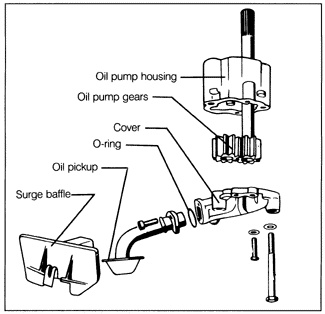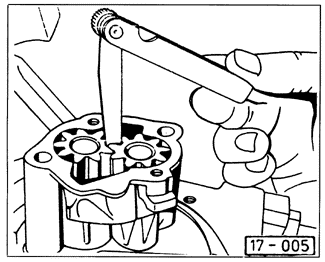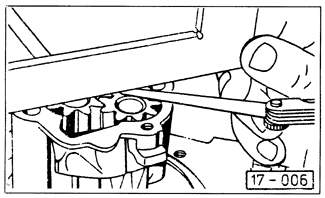7.2 Oil PumpThe oil pump is located inside the engine oil pan, and draws engine oil through a pickup tube from near the bottom of the pan. The pump can be removed for inspection of its internal clearances (a potential source of low oil pressure problems) by removing the oil pan. There is normally no need to remove and inspect the oil pump unless oil pressure is inadequate. Check the oil pressure by installing a pressure gauge in place of one of the oil pressure switches and run the engine. Engine oil pressure at normal operating temperature should be at least 2.0 bar (29 psi) at 2000 rpm. On some early 1985 models, it may be possible to correct low oil pressure by installing the later oil pump. Pump gears have been increased from 26 mm (1 in.) to 30 mm (1 3/16 in.). To inspect the oil pump, drain the oil and remove the oil pan. Remove the pump and disassemble it. See Fig. 7-3.

With the oil pump removed and disassembled, use feeler gauges to check the clearances. Backlash, shown being measured in Fig. 7-4, should be between 0.05 and 0.20 mm (.002 and .008 in.). If not, replace the gears or the pump. Oil pump gear axial play, shown being measured with a straight-edge in Fig. 7-5, should not exceed 0.15 mm (.006 in.). If it does, replace the pump. If the oil pickup has been removed from the pump cover, replace the O-ring when installing the pickup. Before installing new oil pump, be sure to prime it by filling the gear cavity with oil. Torque the pickup bolts and cover bolts to 10 Nm (87 in. lb.). Torque the oil pump mounting bolts to 20 Nm (15 ft. lb.). Replace the oil pan gaskets and install the oil pan. Torque the oil pan bolts to 20 Nm (15 ft. lb.) and the drain plug to 30 Nm (22 ft. lb.). Add engine oil, as described in LUBRICATION AND MAINTENANCE.


|